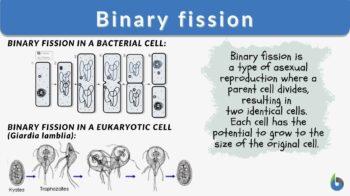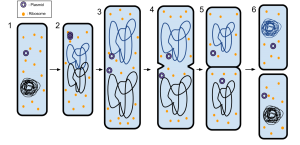
Binary fission
n., plural: binary fissions
[ˈbaɪ.nə.ɹi ˈfɪʃən]
Definition: the asexual mode of reproduction wherein a parent cell divides into two cells, and each cell will grow to the size of the parent cell
Table of Contents
Binary Fission Definition
What is binary fission? In biology, binary fission is a type of asexual reproduction where a parent cell divides, resulting in two identical cells, each having the potential to grow to the size of the original cell. The word asexual describes a reproduction that occurs without involving sex cells (gametes). Instead, the somatic cells undergo an asexual process that will produce a clone of the parent. The offspring is a clone because its genome will be identical to that of the parent. Binary fission is common among prokaryotes, e.g. archaea, eubacteria, cyanobacteria, and certain protozoans (e.g. amoeba).
Binary fission is an asexual type of reproduction. Want to know more about this topic? Come and join us: Advantages and disadvantages of asexual reproduction
Process of Binary Fission
How does binary fission work? Binary fission is the way that prokaryotic cells and certain protozoans reproduce. Similar to other modes of asexual reproduction, such as budding and formation of baeocytes (e.g. in cyanobacterium Stanieria)1, the result is an offspring that has the same genome as the parent.
Prokaryotic binary fission
The prokaryotic cell contains DNA that is tightly coiled prior to cellular splitting. The process starts by creating a replicate of the genetic material. Next, the chromosomes segregate to separate poles of the cell — a process called “karyokinesis”. The cytoplasm is subsequently cleaved into two by a new cell membrane forming (cytokinesis). A cell wall also forms if the original (parent) cell has one. The new cell wall often starts out as a “Z-ring” as formed by the cytoskeleton FtsZ. Below is a diagram depicting a bacterium undergoing cell fission. As shown, the method of bacterial replication appears to be fast and simple. Inside a bacterial cell, the stages are as follows: (1) genomic replication, (2) chromosome segregation, and (3) cytokinesis.

Binary fission in eukaryotic cells
Sexual reproduction is common among eukaryotes; however, some of them can reproduce asexually. Protozoa are examples of eukaryotes that can reproduce by binary fission. Mitochondria, one of the major organelles in eukaryotic cells, divide by binary fission. The process is similar to prokaryotic fission. This is one of the bases of the theory called Endosymbiotic theory wherein primitive prokaryotic cells are presumed to have evolved into the mitochondria that we know today.
Do you think humans can reproduce by binary fission? Why or why not? Let’s talk! Join us here: Advantages and disadvantages of asexual reproduction
Types of Binary Fission
Binary fission has four types according to how the cell divides: (1) irregular, (2) transverse, (3) longitudinal, and (4) oblique.
1. Irregular
In irregular binary fission, the cell divides at any plane. However, it is mostly in a manner perpendicular to where the nuclear division (karyokinesis) occurred.
2. Transverse
In transverse-type, cell division occurs along the transverse axis, hence the name.
3. Longitudinal
In longitudinal binary fission, the cell divides longitudinally.
4. Oblique
In oblique binary fission, cell division occurs obliquely, which may either by left or right oblique.
Differences Between Binary Fission and Mitosis
Binary fission is similar to mitosis in the way that the process ultimately leads to the production of two identical daughter cells. However, they differ in many aspects. While binary fission is for reproductive purposes mitosis is primarily for growth in multicellular organisms. The genetic material is replicated prior to mitosis whereas this stage occurs as part of binary fission. Furthermore, spindle fibers are one of the features that define mitosis. The spindle fibers attach to the chromosomes to move and divide the chromosomes into two equal sets at opposite poles. The new cells from mitosis will not be a new individual as it is in binary fission. They will become a somatic cell that will either develop into a specialized differentiated cell or a cell that divides mitotically to give rise to another set of new cells.
Binary fission vs. Mitosis | |
|---|---|
| Binary fission | Mitosis |
| Function: reproduction | Function: cell growth (in numbers) in multicellular organisms |
| Occurs in prokaryotes and eukaryotes | Occurs in eukaryotes |
| No spindle forms | Mitotic spindle forms |
| Stages: chromosome duplication, chromosome segregation, cytokinesis | Stages: prophase, metaphase, anaphase, telophase |
| Product: two cells with an identical genome | Product: two cells with an identical genome |
Binary Fission Examples
Several organisms perform binary fission. Bacteria, for instance, use it as a way to reproduce. As already mentioned above, bacterial fission entails chromosomal replication, chromosomal segregation, and cell splitting. Another group of organisms that reproduce by binary fission is the protozoa. In protozoan fission, the process is similar as it entails similar fundamental stages. However, protozoa differ from prokaryotes in having mitochondria that have to be duplicated and divided as well. They differ in how their cell splits. For instance, in amoebae, cytokinesis takes place along any plane. Thus, their binary fission exemplifies the irregular type. As for longitudinal-type, Euglena is an example. Ceratium, in turn, is a protozoan in which cytokinesis occurs obliquely. Paramecium is an example of a protozoan whose binary fission is transverse-type.
Explore more about asexual reproduction. Find out why it has some advantages over sexual reproduction. Join our discussion: Advantages and disadvantages of asexual reproduction.
Take the Biology Quiz – Binary Fission!
References
- Binary Fission and other Forms of Reproduction in Bacteria | Department of Microbiology. (2020). Cornell.Edu. https://micro.cornell.edu/research/epulopiscium/binary-fission-and-other-forms-reproduction-bacteria/
©BiologyOnline. Content provided and moderated by BiologyOnline Editors.








